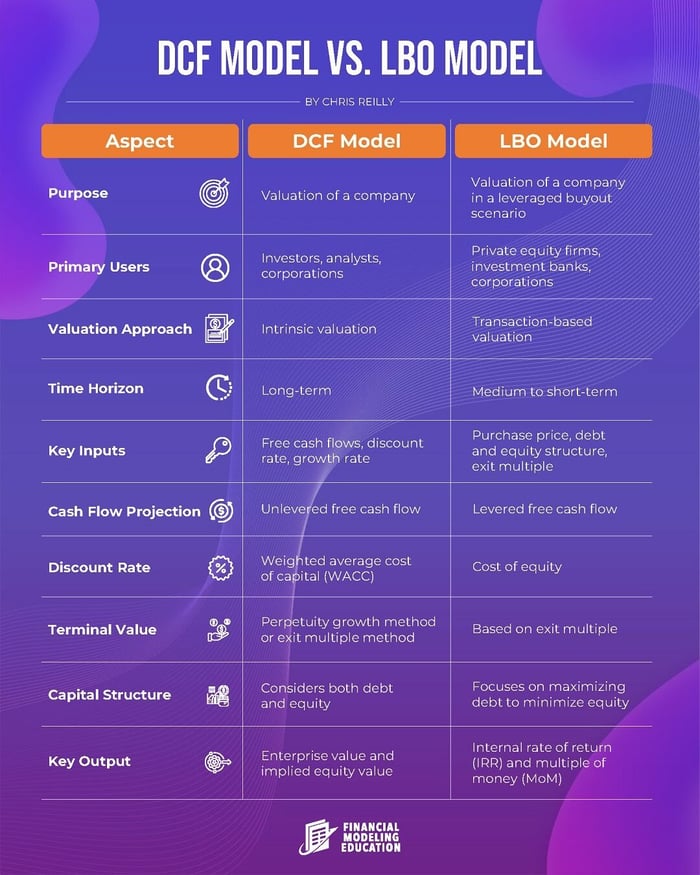DCF vs LBO Models
Ever been up all night wondering what the differences are between DCF and LBO models?
Me neither.
Nonetheless, these two cornerstone valuation techniques are standard tools for finance professionals, yet they serve distinct purposes.
Today let’s break down the differences and understand when and why you’d use each one…
What’s the Difference Between DCF and LBO Models?
DCF Model (Discounted Cash Flow)
The DCF model is your go-to for long-term valuation.
It’s all about understanding the intrinsic value of a company by focusing on its fundamentals.
Here’s are the key characteristics of a DCF model:
- Purpose: Valuation of a company based on future cash flows.
- Primary Users: Investors, analysts, and corporations.
- Valuation Approach: Intrinsic valuation.
- Time Horizon: Long-term.
- Key Inputs: Free cash flows, discount rate, and growth rate.
- Cash Flow Projection: Unlevered free cash flow.
- Discount Rate: Weighted average cost of capital (WACC).
- Terminal Value: Perpetuity growth method or exit multiple method.
- Capital Structure: Considers both debt and equity.
- Key Output: Enterprise value and implied equity value.
DCF models rely heavily on free cash flows and WACC to estimate a company’s value.
They aim to uncover the “true” value of a company by analyzing its revenue, earnings, dividends, and growth rates.
Although DCF models are fundamentally intrinsic, they do incorporate external market factors through elements like the discount rate (WACC) and Beta in CAPM (Capital Asset Pricing Model).
💡Key Concept: DCF valuations can be highly subjective, with minor adjustments in components like growth rate or cash flow stability leading to significantly different outcomes.
This sensitivity often necessitates large sensitivity tables to provide a range of possible outcomes.
LBO Model (Leveraged Buyout)
In contrast, the LBO model is more transaction-based, designed for mid- to short-term analysis, and is a favorite among private equity firms.
Here’s the primary traits of an LBO model:
- Purpose: Valuation of a company in a leveraged buyout scenario.
- Primary Users: Private equity firms, investment banks, and strategic acquirers.
- Valuation Approach: Transaction-based valuation.
- Time Horizon: Medium to short-term.
- Key Inputs: Purchase price, debt and equity structure, exit multiple.
- Cash Flow Projection: Levered free cash flow.
- Discount Rate: Cost of equity.
- Terminal Value: Based on exit multiple.
- Capital Structure: Focuses on maximizing debt to minimize equity.
- Key Output: Internal rate of return (IRR) and multiple of money (MoM).
LBO models place significant emphasis on optimizing the use of debt to enhance returns, focusing on external factors like market conditions and comparable transactions to determine entry and exit points.
This model aims to maximize returns, often measured by IRR and ROI, sometimes referred to as “Cash on Cash” or “Multiple of Money.”
An interesting nuance of the LBO model is that it often establishes a valuation floor due to constraints like IRR and debt paydown goals.
My Personal Experience
In my days working in private equity, we predominantly utilized LBO models.
In fact, DCF models were rarely on our radar.
This preference was driven by the hands-on, transactional nature of private equity work.
While DCF models are great for their theoretical approach to valuation, they can be sensitive — small changes in the discount rate can significantly impact the valuation (again, that’s why they often come with large sensitivity tables).
LBO models, though more complex due to the intricacies of layering in new debt and equity, felt more palatable as both entry and exit points are influenced by current market conditions.
Key Takeaways
- Both models are grounded in business performance, requiring detailed forecasting of the P&L and Balance Sheet.
- You can build both models in a single file if desired, leveraging the strengths of each.
- DCF models are ideal for long-term valuation based on intrinsic value, while also considering external market risks.
- LBO models excel in transaction-based scenarios, particularly in private equity, where market conditions heavily influence decisions.
As always, remember that models are just that — models.
They are abstract representations of potential futures.
The real skill lies in understanding their inputs, interpreting their outputs, and making informed decisions based on their results.
If you’re interested in getting some hands-on experience with LBO modeling, my Financial Modeling Education program features a comprehensive LBO modeling simulation.
It’s a great way to learn what it’s really like to work in middle-market private equity.
That’s it for today. See you next time.
— Chris

